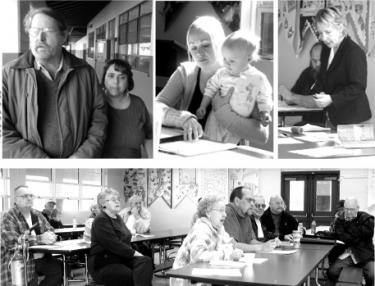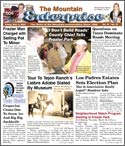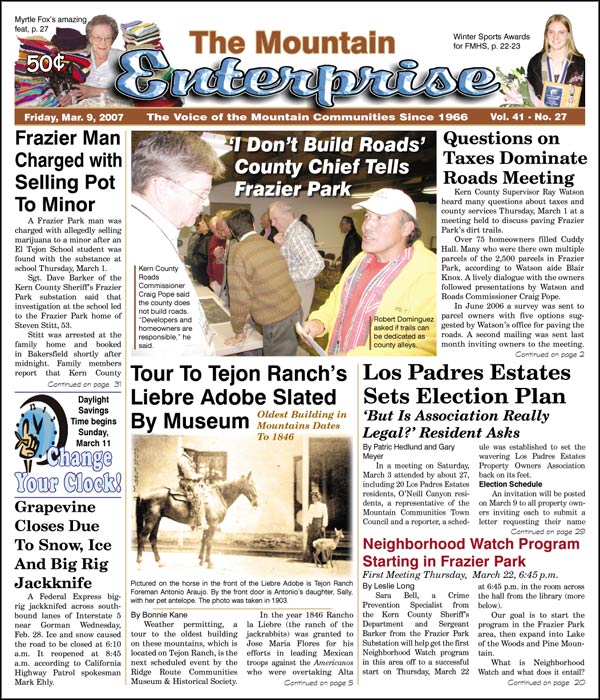
(l-r) Alan and Ann Marie Holland questioned whether Los Padres Estates is operating legally under California laws. Nicola Dubois (with baby) researched Davis-Stirling law and will be a candidate to serve on the board ?to make things better.? John and Linda MacKay brought an association rule book for guidance. Members (below) agreed ?to go door to door? to get their neighbors to participate in the election.
‘But Is Association Really Legal?’ Resident Asks
By Patric Hedlund and Gary Meyer
In a meeting on Saturday, March 3 attended by about 27, including 20 Los Padres Estates residents, O’Neill Canyon residents, a representative of the Mountain Communities Town Council and a reporter, a schedule was established to set the wavering Los Padres Estates Property Owners Association back on its feet.
Election Schedule
An invitation will be posted on March 9 to all property owners inviting each to submit a letter requesting their name be placed on the ballot if they wish to run for the board.
March 28 is the deadline to submit names for the ballot, addressed to PO Box 1131, Lebec, CA 93243.
Ballots will be sent to homeowners on April 13 and a forum to introduce the candidates will be held on Saturday, April 21 at a location to be announced. All votes must be mailed by May 15 or inserted by hand into the ballot box on May 19, the day of the count at El Tejon School Cafeteria.
Neutral Third Party to Follow Davis-Stirling Rules
A neutral third party, the Mountain Community Town Council, will be responsible for the ballots and the count.
Balloting will be conducted according to California’s Davis-Stirling guidelines for property owner associations. The procedure includes mailing one pink double-envelope ballot to the owner of each parcel.
The parcel number is marked on the self-addressed outer envelope. When the owner mails back their vote, the third party checks off the parcel number as having voted, discards the outer envelope and places the sealed inner envelope into the locked ballot box, thereby collecting anonymous ballots for the May 19 count.
If double envelope ballots are hand-delivered on May 19, the bearer will have to provide identification before their ballot will be accepted and inserted in the box.
The MCTC will conduct the count and the results will be announced May 19.
Financial Report
Art Bence said the association currently has $13,000 in its account. Members reported that O’Neill Canyon residents had indicated an interest in helping to maintain the roads that service their properties and pass through LPEPOA. It was stated that O’Neill Canyon owners were in the midst of developing their own property owners association.
Challenge to Legality
Ann Marie Holland pointed out that the LPEPOA has never incorporated or registered with the office of the California Secretary of State. She said she believed that may mean the association is not legally constituted, and may not have a valid basis to collect assessed fees from homeowners.
Research confirms that the LPEPOA has not incorporated or filed with the state, but state law indicates that it is not necessary to do so in order to conduct business as a property owners association.
Legal Requirements
Reporters’ made inquiries with state and county officials, plus one attorney. To summarize, the requirements for operating an HOA or POA appear to be:
1) File with the county the covenants, conditions and restrictions (CC&Rs) declared when the developer creates the Common Interest Development through either a subdivision or a joining of parcels. This Declaration of CC&Rs becomes the main governing document.
2) Or, in the absence of a Common Interest Development, simply form an agreement between any number of homeowners stipulating to what everybody is agreeing.
No incorporation is necessary and it appears that the State of California does not have authority to enforce its demand for biennial Statements of Information unless the POA is a corporation.
Art Bence produced a photocopy of the CC&Rs, showing that the original document was signed by developer Wayne Reedor, and notarized for filing with Kern County on August 20, 1971.
Los Padres Estates residents have struggled for several years because the CC&Rs require a 51% "quorum" of the property owners for an election to be valid. Without that, even a cumulative vote that is just three short of the total needed (as occurred last year) may be ruled invalid. Once a properly elected new board is installed, it can choose to change the quorum requirement. Most POAs today maintain a quorum requirement significantly smaller than 51%.
According to San Francisco attorney Andy Sirkin, state law also says that if a number of homeowners feel the CC&Rs need to be changed, they can petition a judge for such change(s).
This is part of the March 09, 2007 online edition of The Mountain Enterprise.
Have an opinion on this matter? We'd like to hear from you.


